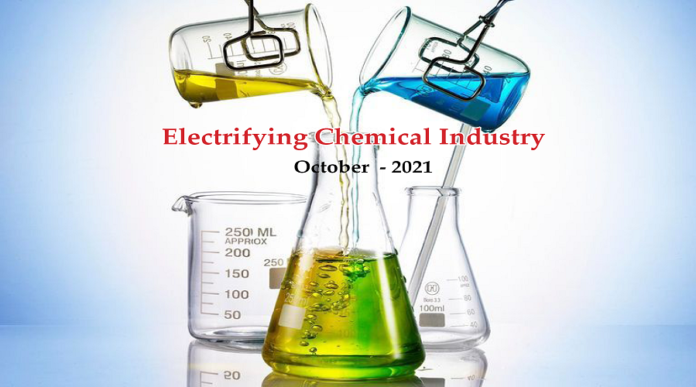Electrochemical processes are energy efficient, safer and have a high atom economy. Coupled with the use of renewable electricity, electrochemical processes are a greener and more sustainable alternative for the production of chemicals. Electrochemistry also opens up hitherto uncharted pathways for synthesis of specific molecules of interest for agrochemical and pharmaceutical industries.
Michael Faraday laid down the laws of electrolysis in 1834 and Hermann Kolbe carried out the first organic electrosynthesis in 1848. While electrolysis is used for the large scale manufacture of caustic soda/chlorine and aluminium, electrochemistry has been received with lukewarm enthusiasm in the production of organic chemicals on an industrial scale. The largest commercial scale organic electrosynthesis process in vogue today is for the manufacture of adiponitrile, a precursor for Nylon 6,6. Commercialised in 1965 by Monsanto, the process involves electrohydrodimerisation of acrylonitrile to adiponitrile. With more and more electricity being generated from renewable resources at lower and lower costs, electrochemistry is experiencing a renaissance. Not only has electrosynthesis emerged as a potential tool in the sustainable manufacture of chemicals, it has also opened up novel mechanistic pathways for innovative chemical transformations. Electrosynthesis has many advantages over conventional methods of synthesising chemicals. It is energy efficient, inherently safe and eliminates waste. However, there are several barriers for the adoption of electrosynthesis in the mainstream chemical industry.
Greener Process
Redox reactions are an important technique for synthesising organic compounds and have been traditionally accomplished by the use of oxidising and reducing chemicals. This conventional approach inevitably leads to generation of waste, which often pose environmental concerns during disposal. Electrosynthesis achieves the redox transformation by replacing chemical reagents with electric current. Redox transformation through anodic oxidation and cathodic reduction does away with the use of oxidising and reducing chemicals and is thus a greener alternative. Another important advantage of electrochemical reactions is that they occur under milder conditions compared to traditional methods which require elevated temperatures and pressures. Electrosynthesis thus saves energy.
Safety
Electrochemistry also confers other advantages that are singularly lacking in conventional chemical processes. Electrochemical reactions are faster and thus require lesser residence time and smaller inventories. The reaction can be controlled with greater precision by manipulating the current or voltage. The reaction can also be stopped instantly by switching off the power. The improved control features coupled with the milder conditions make electrosynthesis safer than conventional processes.
Novel Platform
Besides offering a more sustainable and safer alternative, electrosynthesis provides a uniquely powerful platform to synthesise targeted molecules. Electrochemistry offers redox potentials that are incapable of being achieved by chemical oxidants and reductants. This allows creation of new reactive intermediates and currently unimaginable strategies to synthesise molecules with novel properties. Electrosynthesis enables enantioselective reactions and thus offers great value to agrochemical and pharmaceutical industries.
Energy Economy
Every electrochemical reaction consists of two half-reactions – the oxidation at anode and the reduction at cathode. The two half-reactions are linked to one another through electron transfer from cathode to anode through the electrolyte. But typically, only the anodic oxidation is utilised for synthesis and the cathodic reduction is frittered away. This reduces the energy economy of the overall electrochemical redox reaction. The energy economy can be improved if the reduction reaction at cathode can be gainfully utilised to create another product. This has led to the concept of “paired electrolysis”, in which both the half-reactions are used to produce desirable products at the anode and cathode. One way of achieving this is to carry out the electrolysis in a divided cell, in which the anode and cathode are separated by a semi-permeable membrane. For example, the oxidation of an alcohol at the anode can be matched with the reduction of unsaturated C-C bonds by the hydrogen released at the cathode. The same outcome can be realised by piping away the hydrogen liberated at cathode and carrying out the hydrogenation reaction in a separate reactor.
Flow Reactors
Electrosynthesis is best carried out in Flow Reactors (See Chemingineering – Small is Beautiful, June 2019). Electrochemical reactions are regarded as heterogeneous as they take place at the surface of electrodes. The two key requirements for an electrochemical reactor are a small interelectrode gap so as to minimise the ohmic drop in the electrolyte and having a sufficiently high flow velocity to avoid gas hold-up at the electrode. Flow Reactors will also facilitate easy scale-up from lab to commercial production.
Electrodes
Electrodes are at the core of electrosynthesis. Material of electrodes and their morphology are both important in determining the outcome of the electrochemical reaction. A wide range of materials have been studied by researchers. These include both non-metallic electrodes such as graphitic carbon as well as metallic electrodes. Transition metals such as copper and nickel and noble metals like platinum, palladium and ruthenium have been examined. The electrodes usually provide the oxidising or reducing equivalent of the chemical reagent, but sometimes play a catalytic role. In some situations, active transition metal catalysts are generated electrochemically at the electrodes to drive challenging reactions like C-C coupling and C-H activation. Chemoselectivity, the preference for one functional group over other competing groups, can be induced into redox transformations through the use of appropriately modified electrodes. For example, while carbonyl compounds were produced at a platinum anode, carbon-based anode yielded tetrahydrofuranes. Using different materials for electrodes coupled with appropriate surface modifications, innovative strategies can be developed for molecular synthesis.
CO2 Capture
Electrochemical reduction of carbon dioxide to carbon monoxide and subsequently to valuable feedstocks and fuels is emerging as a promising technology in the battle against global warming. Since the electrochemical reaction can be powered by renewable energy, the technology simultaneously provides an elegant solution to the problem of energy storage. The reduction occurs in the presence of a catalyst and a variety of catalysts have been examined. Catalysts are primarily of two types – transition metals and nanostructures. Copper has emerged as the most effective transition metal catalyst. However, it is plagued by poor efficiency and low stability. Nanostructures of copper supported on graphene have shown encouraging efficiencies in the electrochemical conversion of carbon dioxide to ethanol. Lack of a stable, efficient and inexpensive catalyst continues to be a major impediment in the commercialisation of this technology.
Afterword
A multinational consortium in EU called PERFORM has been set up with the objective of developing electrochemical processes for the production of chemicals from bio-feedstocks. Under this initiative, two demonstration projects are under development – one for electrochemical production of maleic acid from furfural paired with production of valeric acid from levulinic acid and the other to produce adipic acid from glucose.
Readers’ responses may be sent to:
k.sahasranaman@gmail.com or
chemindigest@gmail.com

































